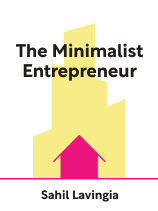

This article is an excerpt from the Shortform book guide to "The Minimalist Entrepreneur" by Sahil Lavingia. Shortform has the world's best summaries and analyses of books you should be reading.
Like this article? Sign up for a free trial here.
What is product experimentation? Why should you test your product before you sell it?
In The Minimalist Entrepreneur, Sahil Lavingia says that product experimentation is an important step in building a business. By trying your product out and getting feedback, you’ll see where you can improve your product.
Here’s how to conduct product experimentation.
Experiment and Adjust
When you’ve determined your community and its problem, you’ll next want to do what Lavingia calls “processizing,” which is essentially a process of product experimentation. This means you’ll try things out and get feedback, adjust accordingly, and try something else. He offers some advice for a few possible avenues to turning your problem into a monetizable solution. You could:
- Sell your knowledge in classes, workshops, podcasts, video tutorials, or books.
- Sell a physical product you’ve designed and/or made.
- Offer a service people need.
- Create a way to connect people (for example, a social media app).
- Create software solutions.
Lavingia suggests you start out by offering your product or service to your community on a freelance basis or as a side project, to see what people are willing to pay for (and how much they’re willing to pay). So, for example, you might offer a workshop to your community and see who signs up. If it doesn’t go well, try a different topic or format. If you want to provide a service—for example, graphic design—start offering it as a side job, and see what kinds of projects people request most often. Be patient, because this process can take years to develop into a successful business.
Lavingia also suggests you reach out to family and friends during this phase. Offer them a trial or sample of your product or service (or sign them on as paying customers if they’re willing) and ask them for honest feedback. He says you can also ask your circle of acquaintances how much they think they’d pay for your product to get your pricing nailed down. A few bits of advice Lavingia offers for pricing are:
- Don’t undervalue your product.
- Factor in the costs you have and then how much profit you’ll need to add to the price.
- Think about making tiered prices, for different levels of service or product features (this is especially common with software businesses).
- Remember pricing is not permanent. You can always adjust it later. You may want to start lower and then go up as your products/services improve.
As you experiment and receive feedback, Lavingia emphasizes that you should take copious notes on what works and what doesn’t. Use this information to recalibrate, and keep trying. He says you may need to experiment with a number of directions and price points before settling on what works. Don’t get discouraged; just keep trying. Eventually, he says, you will have found your niche and be ready to launch your business. The next section will cover the steps toward getting your business off the ground.
Test Your Problem and Solution
When you think you have an idea about what problem you want to solve, you may want to test this idea to see if it’s what people really want. In The Lean Startup, Eric Ries suggests developing a hypothesis and testing it, like a scientist. He says this involves two questions:
- Does the customer have the problem you’re trying to solve, and does your product solve it for them?
- How will the company continue to grow once you’ve delivered the solution?
Ries suggests you set up an experiment and collect data to answer these questions. This should involve tracking peoples’ behaviors instead of asking them what they want because people aren’t always good at explaining what they want. For example, you might offer samples and see what people like best, or track what people click on and react to most on your website or social media.
Determining Your Price Point
The authors of Blue Ocean Strategy give additional advice for determining the right price for your product:
- Research all of the alternatives to your product. Examining this data will give you an idea of the range of prices customers might be willing to pay. Consider products that are similar to your own, as well as ones that are different but fulfill a similar purpose—for example, if you’re offering coaching, you’ll want to look at other coaching programs, as well as classes or books that customers might purchase to get the same information. Graphing the data may help you analyze it. See examples of how you can do that here.
- Consider the uniqueness of your product. If it’s something nobody else can easily replicate (say, it’s patented or copyrighted), that can add value.
- Consider the production costs, but don’t limit your price based on this. Some products may have a value far beyond their production cost, and will thus have a higher profit margin. Don’t sell yourself short.
- A competitive price will have wider appeal than a “premium” price designed to appeal to only a select population.

———End of Preview———
Like what you just read? Read the rest of the world's best book summary and analysis of Sahil Lavingia's "The Minimalist Entrepreneur" at Shortform.
Here's what you'll find in our full The Minimalist Entrepreneur summary:
- Detailed advice for starting your own business without venture capital
- How to run your business sustainably and contribute to the world
- Why you don’t need to spend any money on marketing






